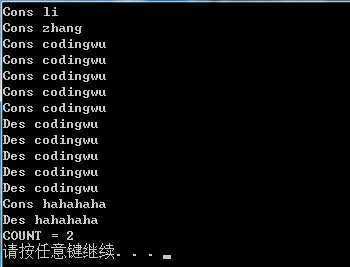标签:
本文地址:http://www.cnblogs.com/archimedes/p/cpp-static2.html,转载请注明源地址
定义:
以关键字static声明的数据成员
class Box { public: int volume() const; private: int iwitch; int length; int heigth; static int count; };
初始化:
类型 类名::静态数据成员名 [= 初值];
class Box { public: int volume() const; private: int iwitch; int length; int heigth; static int count; }; int Box::count; //必须在类外初始化
注意:不能通过构造函数初始化、不能通过初始化列表初始化
访问:
静态数据成员属于类而不属于具体的对象,为不同对象共有。因此,公有静态数据成员在类外的访问方式有两种
类名::公有静态数据成员
对象名.公有静态数据成员
void Box::display()const { cout << Box:: s_iCount << " "; cout << s_iCount << " "; }
存储:
静态数据成员编译时开辟内存单元,占据全局区类的对象创建前就能使用。
为什么要引入静态数据成员?
各对象之间的数据有了沟通的渠道,实现了数据的共享,C++中涉及到对象之间的数据共享时应使用静态数据成员,而不要使用全局变量,因为全局变量不能体现封装特性。
#include <iostream> using namespace std; class Type { public: Type(int ax=0); static int s_value; void print(); private: int m_value; }; int Type::s_value; Type::Type(int ax) { m_value=ax; } void Type::print() { cout<<"m_value=" <<++m_value <<endl; cout<<"s_value=" <<++s_value <<endl; } int main() { Type::s_value=90; Type c1,c2; c1.print(); c2.print(); system("PAUSE"); return 0; }
应用举例:统计创建对象的个数
#include <iostream> #include <string> using namespace std; class student { public: student(string aName="codingwu") { strName=aName; count++; cout << "Cons"<<" "<<strName <<endl; } ~student() { count--; cout<< "Des"<<" "<<strName<<endl; } void printCount()const { cout<<"COUNT = "<<count<<endl; } private: static int count; string strName; }; int student::count; int main() { student stu("li"); student stu1("zhang"); student *p=new student[5]; delete []p; student("hahahaha"); stu.printCount(); system("PAUSE"); return 0; }
运行结果:

1、概念:
用static声明的成员函数
2、访问方式:
属于类类型的而不属于具体对象
3、特点
①静态成员函数专门用于访问静态成员(包括数据成员和成员函数)
②是属于类的而不属于具体对象,因此既可以通过类名访问,也可以通过对象名引用
③其实静态成员函数就是在类内的全局函数
#include <iostream> using namespace std; class Type { public: static void print(); Type(int aValue = 0); private: int m_iValue; static int s_iValue; }; int Type::s_iValue; Type::Type(int aValue) { m_iValue = aValue; s_iValue++; } void Type::print() { //cout << ++m_iValue;//Error cout << s_iValue << endl; } int main() { Type::print(); Type c1,c2; c1.print(); c2.print(); return 0; }
注意:
非静态成员函数可以访问本类中的任何成员
静态成员函数专门用于访问静态成员,不能直接访问非静态成员。
#include <iostream> #include <string> using namespace std; class Student { public: Student(int aNum=0,int aAge=0,double aScore=0); void total(); static double s_average(); double m_iScore; private: static int s_iCount;//对象个数 static double s_iSum;//总成绩 int m_iNum; int m_iAge; }; double Student::s_iSum; int Student::s_iCount; Student::Student(int aNum,int aAge,double aScore):m_iNum(aNum),m_iAge(aAge), m_iScore(aScore) { } void Student::total() { s_iSum += m_iScore; s_iCount++; } double Student::s_average() { return s_iSum/s_iCount; } int main() { Student stud[3] = { Student(1001,18,60), Student(1002,19,90), Student(1005,20,0), }; for(int i = 0;i<3;i++) stud[i].total(); cout << Student::s_average()<<endl; system("PAUSE"); return 0; }
标签:
原文地址:http://www.cnblogs.com/archimedes/p/cpp-static2.html